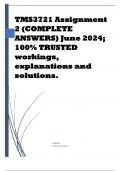TMS3721 Assignment
2 (COMPLETE
ANSWERS) June 2024;
100% TRUSTED
workings,
explanations and
solutions.
ADMIN
[COMPANY NAME]
,Question 1 What do you think is the role of the theories in assisting
the Life Orientation teacher in attending to the academic diversity of
learners in the Further Education and Training Phase? In your
discussion, you should define what a theory is, and the meaning of
diverse learning needs in the classroom. Use references in your
discussion and apply the Harvard referencing style. (10)
Introduction
Theories play a crucial role in guiding Life Orientation (LO)
teachers in addressing the academic diversity of learners in the
Further Education and Training (FET) phase. This discussion will
define what a theory is, elucidate the concept of diverse learning
needs in the classroom, and explore how various theories assist LO
teachers in meeting these needs.
Definition of Theory
A theory can be defined as a systematic set of principles and
propositions that explain and predict phenomena. In education,
theories provide frameworks that help educators understand how
students learn and develop, thereby guiding teaching strategies and
practices (Slavin, 2018).
Diverse Learning Needs
Diverse learning needs refer to the varying academic, social,
emotional, and physical requirements of students within a
classroom. These differences can arise from a multitude of factors
including, but not limited to, cognitive abilities, cultural
backgrounds, socio-economic statuses, language proficiencies, and
learning styles (Tomlinson, 2014). Addressing these needs requires
, teachers to adopt inclusive and differentiated instructional strategies
that cater to the individual strengths and challenges of each student.
Role of Theories in Addressing Academic Diversity
1. Constructivist Theory
Constructivist theory, primarily associated with Piaget and
Vygotsky, posits that learners construct knowledge through
experiences and social interactions (Piaget, 1952; Vygotsky,
1978). For LO teachers, this theory underscores the importance
of creating a learner-centered environment where students
actively engage in the learning process. By incorporating group
work, discussions, and problem-solving activities, teachers can
cater to diverse learning styles and foster collaborative
learning, thereby addressing the diverse academic needs of
students.
2. Multiple Intelligences Theory
Howard Gardner’s theory of multiple intelligences suggests
that individuals possess different kinds of intelligences, such as
linguistic, logical-mathematical, spatial, musical, bodily-
kinesthetic, interpersonal, intrapersonal, and naturalistic
(Gardner, 1983). Recognizing these varying intelligences helps
LO teachers design diverse instructional strategies that appeal
to different strengths. For instance, a lesson on stress
management could include written reflections, group
discussions, role-plays, and artistic expressions, thus engaging
students with different intelligences.
3. Differentiated Instruction
Carol Ann Tomlinson’s model of differentiated instruction
advocates for tailoring teaching methods to meet the varied




